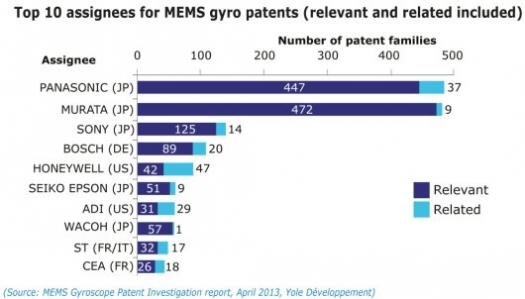Yole: Patents in MEMS gyro not necessarily the key to success

MEMS gyroscopes are currently a very hot topic.
And investigating the patent situation is essential to understanding the present business climate and anticipating future developments.
According to Yole Développement, the gyroscope market is driven by mobile applications, where until recently only two players, STMicroelectronics (ST) and InvenSense, were competing.
Now, many companies are present. The first patent disputes to develop over the last few years (linked to Wacoh's patents) or that are currently occurring (ST vs. InvenSense) signal the beginning of a fight for gyro and inertial combo market ownership.
Yole's report, "MEMS : MEMS Gyroscope Patent Investigation," provides an insight into the technical trends the market analyst has observed in the industry.
From the aforementioned disputes, IP is critical in this area. And so the link between IP and market evolution is critical as well. An important finding that Yole made was that focus has shifted to the software side, where considerable value can be created.
Indeed, an increasing number of companies with different value chain positions are developing functionalities based on MEMS gyroscopes, along with related IP.
The key players' patent portfolios
About 200 players are involved in MEMS gyroscope technologies, but the top 10 represent 63 percent of the patents filed. Yole says Panasonic and Murata lead the way. Both were early players in the industry, with piezo/ceramic style gyroscopes.
Other players such as Analog Devices, Robert Bosch, ST and InvenSense developed their technologies based on silicon substrates and the capacitive detection principle.
But according to Yole, these players' MEMS portfolios are generally much larger than what's included in the report. Basically, many of their patents are generic publications which can apply to many types of MEMS components, and not specifically to gyros.
For Yole's MEMS gyroscope patent analysis, more than 4,700 patent families were screened. Fifty three percent of them were classified as relevant or related, and worthy of further study.
A closer look revealed that intense patenting activity began in the late 80's, stabilised in the 90's and then increased over the past 10 years.
The first MEMS gyroscope patents are quite old and the technology has evolved greatly in the past few years, so understanding the most recent evolutions is essential.
"In domain" patents are mostly filed by firms and universities located in Japan and the USA. However, a significant portion of the actual business is done by German (Robert Bosch) and Italian (ST) companies.
According to Yole, the lesson is that generating patents doesn't necessarily mean generating business.

































